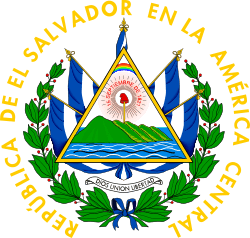Religion in El Salvador
El Salvador's approximately 6.2 million inhabitants (July 2017) are mostly Christian.[1] Evangelical Protestantism is experiencing rapid growth in recent decades while the Catholic share of the population is on decline.[3]
Religion in El Salvador (Pew Research Center 2014)[2]
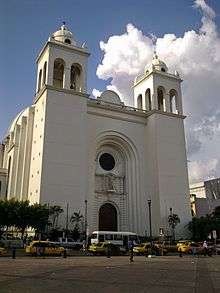
Religious affiliation
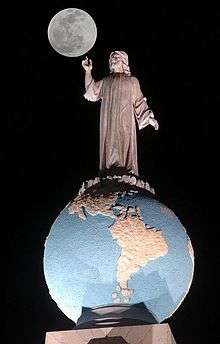
There is some debate about percentages, the Institute of Public Opinion of the University of Central America in May 2017 found 47.5% of the population as Roman Catholics, and 35.1% as Protestant, 14.5% as not having a religion and the remainder (about 3%) being Jehovah's Witnesses, International Society of Krishna Consciousness, Muslims, Jews, Bahais, Buddhists, Latter-day Saints (Mormons), and members of indigenous religions.[1] However Latinobarómetro in 2017 found 39% were Catholic, 28% Protestant, 30% atheist/agnostic/not religious, 2% other religions, and 1% did not answer.[4] It also found in 1996 that 67% of the population considered themselves Catholic and 15% Protestant.[4]
Churches of El Salvador
 Iglesia El Rosario, San Salvador
Iglesia El Rosario, San Salvador

- Iglesia Don Rua, San Salvador
- Iglesia El Calvario, San Salvador
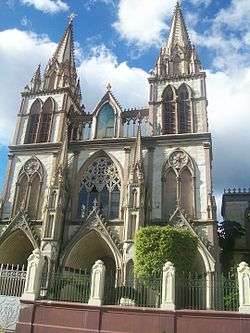
 Basílica del Sagrado Corazón de Jesús, San Salvador
Basílica del Sagrado Corazón de Jesús, San Salvador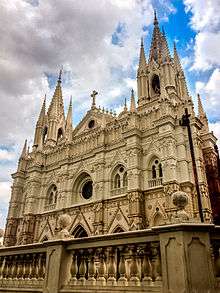
- Iglesia Santa Lucía, Suchitoto
 Church in Dulce Nombre de María
Church in Dulce Nombre de María Iglesia El Carmen, Santa Ana, El Salvador
Iglesia El Carmen, Santa Ana, El Salvador Iglesia Nuestra Señora de la Asunción, Ahuachapán
Iglesia Nuestra Señora de la Asunción, Ahuachapán
 Iglesia Nuestra Señora de Candelaria, San Salvador Department
Iglesia Nuestra Señora de Candelaria, San Salvador Department Iglesia del Cristo Negro, Juayua
Iglesia del Cristo Negro, Juayua Iglesia de San Pedro Perulapán
Iglesia de San Pedro Perulapán Iglesia Parroquial de Santiago Apostol, Santiago Texacuangos, San Salvador Department
Iglesia Parroquial de Santiago Apostol, Santiago Texacuangos, San Salvador Department- Iglesia del Perpetuo Socorro, San Salvador
 Iglesia El Calvario San Miguel, San Miguel, El Salvador
Iglesia El Calvario San Miguel, San Miguel, El Salvador- Iglesia Parroquial de San José Guayabal

- Iglesia Parroquial San Miguel Arcangel in Ilobasco
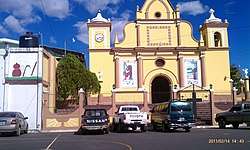 Iglesia San Francisco Gotera
Iglesia San Francisco Gotera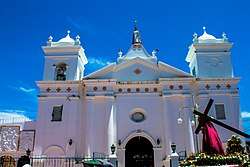 Iglesia Santa Barbara en Sensuntepeque
Iglesia Santa Barbara en Sensuntepeque Parroquia Santiago Apostol, Chalchuapa
Parroquia Santiago Apostol, Chalchuapa- Iglesia el Calvario, Santa Ana, El Salvador
- Iglesia de San Pedro Nonualco
 Iglesia de la Parroquia Nuestra Señora de los Dolores Izalco
Iglesia de la Parroquia Nuestra Señora de los Dolores Izalco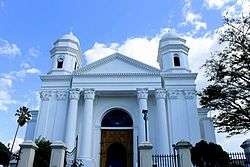
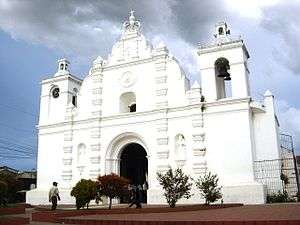 :Iglesia Parroquial San Juan Evangelista, San Juan Opico
:Iglesia Parroquial San Juan Evangelista, San Juan Opico- Iglesia de Panchimalco
Protestant denominations
| Denomination | Percent |
|---|---|
| Assemblies of God | 21.3 |
| Bautista Amigos de Israel | 11.5 |
| Elim | 9.0 |
| Church of God | 7.0 |
| Baptist | 7.0 |
| Profética (Prophetic) | 6.1 |
| Pentecostal | 4.5 |
| Apóstoles y Profetas (Apostles and Prophets) | 3.9 |
| La Luz del Mundo | 3.7 |
| Adventists | 2.9 |
| Príncipe de Paz (Prince of Peace) | 2.2 |
| Others | 12.6 |
| No denomination | 2.2 |
Mision Cristiana Elim Internacional is a large pentecostal denomination started in El Salvador. It claims that its main church in San Salvador has 120,000 attending.[6] The Assemblies of God claim 285,226 members (2007).[7]
The Mormons claim 120,317 people in 164 congregations and 1 temple (2015)[8] which if correct would be just under 2% of the population. An IUDOP study in 2009 found that Mormons were 2% of the Protestants they surveyed or about .8% of the total population.[5] They started evangelizing in El Salvador in 1951.[8]
The Anglican Church in El Salvador (a diocese of the province of the Anglican Church in Central America) claims 6,000 members in 18 congregations.[9] The Baptist Association of El Salvador claims 4,427 members[10] and the Salvadorean Lutheran Synod about 15,000 in 68 congregations.[11]
Statistics
| Group | % 2000 | % 2010 | Pop. 2000 | Pop. 2010 |
|---|---|---|---|---|
| Roman Catholicism | 53.3% | 49.5% | 3.152.953 | 3.085.359 |
| Non-religious | 23.8% | 17.4% | 1.407.872 | 1.084.550 |
| Pentecostalism | 10.8% | 14.5% | 638.872 | 903.792 |
| Independent evangelical | 5.0% | 10.5% | 295.774 | 654.470 |
| Mormon | 2.0% | 2.6% | 118.390 | 162.059 |
| Other religions | 1.2% | 1.5% | 70.985 | 93.496 |
| Historical Evangelical Denominations | 1.4% | 1.1% | 82.816 | 68.563 |
| Muslim | 0.9% | 1.0% | 53.235 | 62.330 |
| Seventh-day Adventist | 0.6% | 0.8% | 35.490 | 49.864 |
| Eastern Orthodoxy | 0.7% | 0.6% | 41.405 | 37.398 |
| Jehovah's Witness | 0.3% | 0.5% | 17.746 | 31.165 |
| Total | 100.0% | 100.0% | 5.915.484 | 6.233.049 |
Religious freedom
The constitution of El Salvador provides for the freedom of religion and prohibits religious discrimination. Publicly offending others' religious beliefs or damaging religious objects is punishable by imprisonment. Members of the clergy may not hold senior government positions, and are forbidden from joining political parties.[13]
Religious groups may register with the government for the purposes of tax-exemption and acquiring building permits. Special visas are required for individuals who wish to travel to El Salvador to engage in proselytizing.[13]
Public school education is secular. Private schools may include religious content in their curricula, but do not receive government support.[13]
Since 2016, clergy have limited access to prisons, due to concerns that some members of the clergy were using prison visits to smuggle items into prisons.[13]
See also
- Demographics of El Salvador
- Roman Catholicism in El Salvador
- The Church of Jesus Christ of Latter-day Saints in El Salvador
- Islam in El Salvador
- Judaism in El Salvador
References
- "International Religious Freedom Report for 2017: El Salvador". www.state.gov. Retrieved 31 December 2018. For percentages it cites the Institute of Public Opinion of the University of Central America May 2017 survey.
- "Religion in Latin America: Widespread Change in a Historically Catholic Region" (PDF). November 2014. Retrieved 17 December 2019.
- Stephen Offutt, New Centers of Global Evangelicalism in Latin America and Africa (Cambridge University Press, 2015) focuses on El Salvador the north central south America and South Africa.
- "Latinobarómetro 1995 - 2017: El Papa Francisco y la Religión en Chile y América Latina" (PDF) (in Spanish). January 2018. Retrieved 23 August 2018.
- "La religión para las y los salvadoreños" (PDF). Instituto Universitario de Opinión Pública Boletín de prensa (in Spanish). San Salvador, El Salvador: r: Universidad Centroamericana José Simeó. 24 (4): 2. 2009. Retrieved 28 April 2015.
- "Células". Elim Mision Cristiana. Retrieved 26 April 2015.
- Triplett, Don. "King's Castle 24/7 Prayer Fortress". Assemblies of God World Mission. Retrieved 26 April 2015.
- "El Salvador". Newsroom. The Church of Jesus Christ of Latter-day Saints. Retrieved 26 April 2015.
- "Iglesia Anglicana de El Salvador". Retrieved 26 April 2015.
- "Baptist Association of El Salvador". World Council of Churches. Retrieved 26 April 2015.
- "Salvadorean Lutheran Synod". World Council of Churches. Retrieved 26 April 2015.
- Holland, Clifton. "Religious profile of Guatemala" (PDF). www.prolades.com. PROLADES. Retrieved 2015-12-22.
- International Religious Freedom Report 2017 El Salvador, US State Department, Bureau of Democracy, Human Rights, and Labor.
https://www.cia.gov/library/publications/the-world-factbook/geos/es.html
Further reading
- Stephen Offutt, New Centers of Global Evangelicalism in Latin America and Africa (Cambridge University Press, 2015) focuses on El Salvador and South Africa. online review
